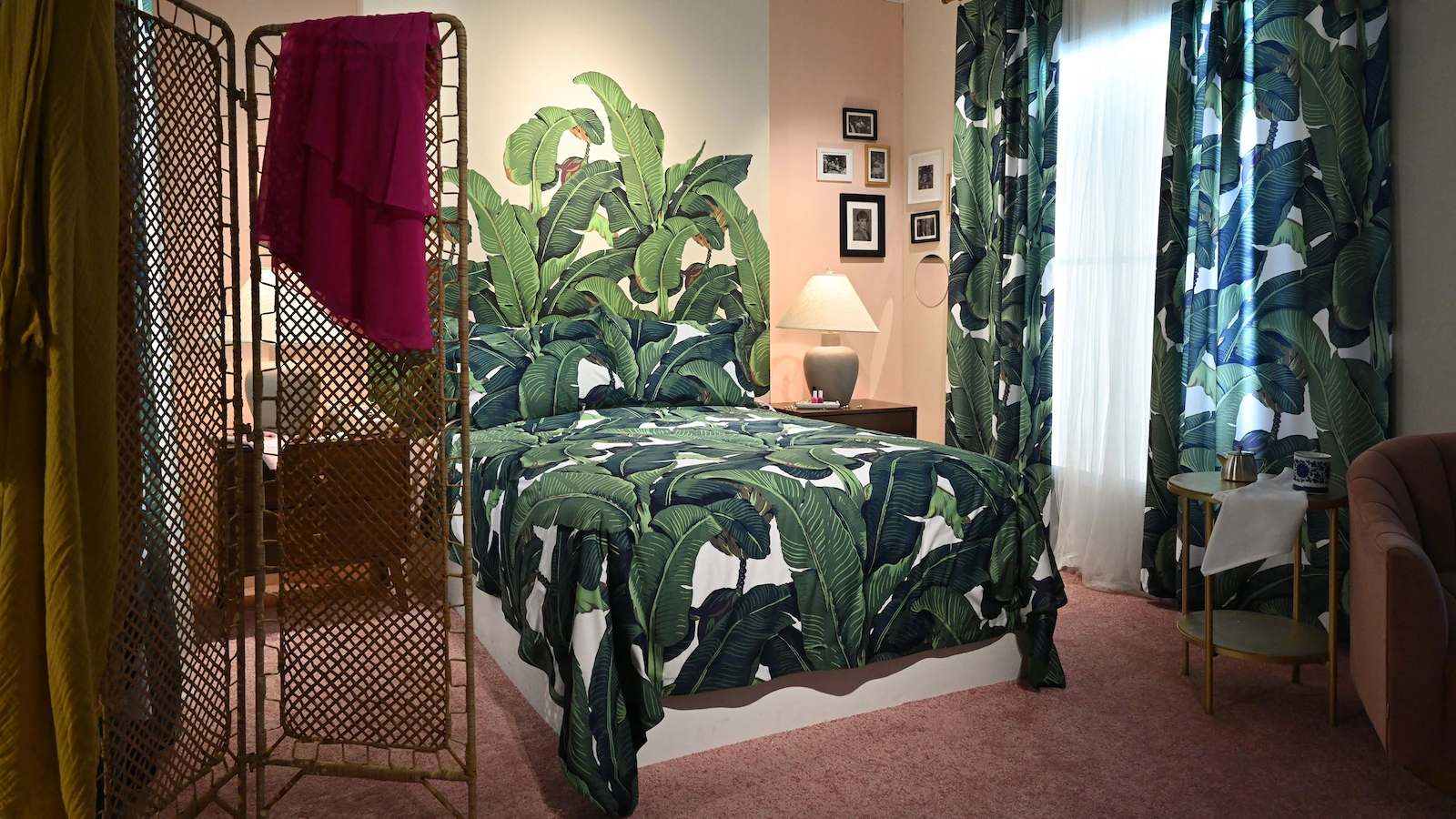Copyright ABC News

If the "Golden Girls" wallpaper could talk, it would probably spill the tea on why it's actually the main character of the iconic show. The bold green banana leaf motif, called Martinique, appears in Blanche Devereaux's bedroom on the hit show and has mesmerized fans and interior designers for decades due to its unique and timeless quality. Ahead of "The Golden Girls: 40 Years of Laughter and Friendship -- Special Edition of 20/20," airing Nov. 11 on ABC, we're peeling back the layers behind the wallpaper that helped define the beloved television show, as well as other iconography that has inspired everything from stylish fashion collections to merchandise that fans have loved over the years. “The Golden Girls: 40 Years of Laughter and Friendship – Special Edition of 20/20” airs Tuesday, Nov. 11, at 10 p.m. EST on ABC and streams next day on Disney+ and Hulu. "I think the 'Golden Girls' aesthetic hits the perfect kind of sweet spot between camp, kitsch and fashion," said Daniel Silverstein, a self-described "lifelong 'Golden Girls' fan" and the Brooklyn-based fashion designer behind "Zero Waste Daniel," who launched a "Golden Girls"-inspired capsule collection in honor of the show being on the air for 40 years. "There's stuff about it that's really recognizable and fun and iconic, but there's also enough motifs like the wallpaper and the sofa that allow you to play on one note and turn up the volume all the way to camp." What is the origin of Martinique? When many think of "Golden Girls," perhaps what first comes to mind is the iconic green Martinique wallpaper in Blanche's bedroom. The unique tropical pattern -- which fittingly shares its name with the Caribbean island Martinique -- dates back to the early 1940s. In 1941, Lucile Chatain -- the daughter of Clifton W. Stockwell, founder of the Los Angeles-based wallpaper and textile company CW Stockwell -- and her husband Remy Chatain Sr. traveled to the Bahamas and were "besmirched by the drama and scale of the banana leaf palms," CW Stockwell CEO Katy Polsby told "Good Morning America." After Lucile Chatain returned from her trip to the Bahamas, she commissioned noted illustrator Albert Stockdale of Pasadena, California, to design a pattern that took inspiration from the banana leaf palms. In 1942, the now-famous print was born. Polsby, whose family was close friends with Lucile Chatain's son Remy Chatain Jr., said that the print was immediately hung in the CW Stockwell showroom, where it would eventually be spotted by Hollywood costume designer Don Loper. Where did Martinique appear next? In 1948, Loper was working as an interior designer tasked with updating the Beverly Hills Hotel and chose Martinique to give the iconic hotel a refresh. The renovation of the Beverly Hills Hotel was completed in 1949. Polsby said that because the print is now part of the hotel's historic landmark designation, it can never be taken down. The banana leaf motif wallpaper later made its way to New York City in the early 1980s, where it was installed inside the beloved French-Vietnamese restaurant Indochine. When did Martinique make its television debut? Nearly four decades after the print was conceived, it made its television debut in the 1985 pilot episode of "The Golden Girls." Audiences were introduced to Dorothy (Bea Arthur), Rose (Betty White), Sophia (Estelle Getty) and Blanche (Rue McClanahan), a group of four women sharing a house in Miami in their "golden years." In the show's pilot episode, which revolved around Blanche's engagement, fans got a glimpse of her bedroom, which featured the iconic Martinique design on her bedsheets, drapes and wallpaper. Polsby said that at the time, Remy Chatain Jr. was close friends with "Golden Girls" set decorator Ed Stephenson, and the belief is that the former sold Stephenson the wallpaper, drapery and the custom bedspread. "There is a tale that basically, they filmed the pilot and the set decorator was worried that in between the time of the pilot airing and knowing whether the series had been greenlit, he did not want the bedspread to go missing because it had been so expensive to make," Polsby said. She added, "He kept it safely in his home for, I don't know, some period of three or four months until they knew whether the show was greenlit." How Martinique added to Blanche's character As for how Martinique meshed so well with Blanche's personality, Polsby said that it embodied everything about who she was. "I think her personality was so resort-like," Polsby said. "I think she always wanted to have a good time. She was always doing exactly what she wanted to do, and it was Blanche's way -- and I think that speaks a lot to the sort of atmosphere she created in her room, which was this sort of dreamy escape of a place." She continued, "I think she wanted to create sort of a really peaceful but bold escape in her room and have it be a place where anyone, any visitor might also enjoy being there. And I think that she was also somebody who lived her life very openly, very vivaciously." "I always joked what she might have lacked in taste for her suitors, she made up for in taste for her interior decorating style," she added. How Polsby is carrying on the legacy of the iconic design Since taking over CW Stockwell as CEO, Polsby said she has taken it upon herself to share the storied history behind Martinique with others and also protect the legacy of the CW Stockwell brand. "It's a total dream job, because it's something that speaks to me," she said. "It's something that I can connect with. So that makes a huge difference for me in his case, where Martinique is sort of our mascot." "I love to honor the legacy of Lucile for creating it," she continued, "and Remy, her son, for continuing the company going forward -- just sort of continuing to build the brand name in our new modern era is really important." She added, "It's truly an honor to carry the torch for it." How the 'Golden Girls' aesthetic continues to stay iconic Beyond the Martinique design, the "Golden Girls" aesthetic has continued to inspire in many homes today. Patrick Hinds, the co-host of the "Golden Girls Deep Dive" podcast, said so many fans of the show still talk about the women's house. "We've got that gorgeous house that makes no sense," Hinds said. "This is apparently a five bathroom house. The wicker furniture that is so ugly, yet we all secretly kind of want it. The kitchen table that should have four seats but only has three." In terms of style, Kristen Meinzer, a film and TV pop culture critic and "Golden Girls" enthusiast, said that despite what some might think now, how the women dressed on the show was very fashionable for their time. "A lot of people were wearing that outfit," she said, referring to one of Rose's ensembles -- stone-washed jeans with white Keds and an oversized sweatshirt. She added that the hairstyle Blanche had was also identical to the hairstyle Princess Diana had back then too. Author Jim Colucci, who wrote "The Q Guide to the Golden Girls" and "Golden Girls Forever: An Unauthorized Look Behind the Lanai," said the outfits that the women were wearing back then are still relevant now. "They're things that you could be wearing now and they may come in and out of fashion a little bit, but they're not extreme," he said. "And I think that there's so much about the show that was a happy accident, that it doesn't age badly."



